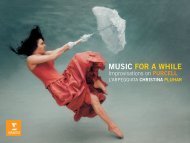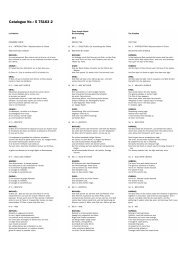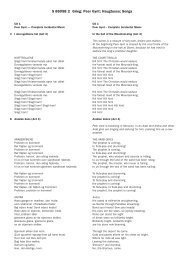MEDITERRANEO - EMI Classics
MEDITERRANEO - EMI Classics
MEDITERRANEO - EMI Classics
Create successful ePaper yourself
Turn your PDF publications into a flip-book with our unique Google optimized e-Paper software.
7<br />
centres not only of Greek culture, but also of social and economic prosperity, since alongside prayer<br />
and asceticism the monks devoted themselves to cultivating the fields and producing wine and oil.<br />
This initial flow of immigration was soon followed by another prolonged wave. In 867<br />
Emperor Basil I succeeded to the throne of Constan tinople. He had taken it upon himself to fight<br />
the Arab invaders in both the Western and the Eastern Empires. Large parts of southern Italy had<br />
fallen into the hands of the Arabs, whose raids had laid waste towns and countryside. The monks<br />
were forced to leave Sicily and Calabria and sought refuge in Salento. Their communities often<br />
created new dwellings in caves that afforded them protection. Most of these settlements were located<br />
in the area of Taranto, where the morphology of the terrain, with its gorges and high cliffs, was<br />
favourable to the construction of such protected villages. As a result of this migration, around forty<br />
villages grew up in the centre of the Salento region, between Otranto and Gallipoli.<br />
The early eleventh century saw the first raids by new invaders from northern Europe, and in<br />
the space of a few decades the Normans brought the power of the Byzantine Empire in southern<br />
Italy to an end, creating a unitary state there and introducing feudal ism. The new rulers were of the<br />
Roman Catholic rather than the Orthodox faith, but left the Greek population in peace. However,<br />
although there were no religious conflicts with the Orthodox Greeks in southern Italy, by the early<br />
fifteenth century Ortho dox monasticism had entirely disappeared and was replaced by Franciscan<br />
and Dominican foundations. After the Council of Trent in 1563, the Greek Ortho dox clergy was<br />
also supplanted by Catholic priests, thus obliging the Orthodox community to hold its services, its<br />
prayers and liturgy in Latin, a language it did not speak. As a result, the proportion of Greekspeaking<br />
inhabitants gradually diminished, especially in the villages on the Ionian Sea.<br />
In 1945, Grecìa Salentina, within the Salento peninsula, still had about 40,000 residents who<br />
spoke fluent Griko, concentrated in the villages of Calimera, Castrignano, Corigliano, Martano,<br />
Martignano, Sternatia and Zollino. There is also a Calabrian Griko region that consists of nine<br />
villages in the inaccessible mountainous region of Bovesia, includ ing Bova Superiore, Roghudi,<br />
Gallicianò, Chorio di Roghudi and Bova Marina, and four districts in the city of Reggio Calabria,<br />
but its Greek population is considerably smaller than in Salento.<br />
After the Second World War, complex socio-economic factors such as the influence of radio<br />
and television, schools and newspapers gradually reduced the number of Griko speakers still further.








